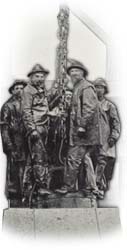



    |
|
|
Sense of Community
|
|
The mining areas of Cape Breton tend to be groups of communities bound together by the mining operations to form one town, village or city. This is perhaps most notable in the town of Glace Bay. Ethnic groups tended to be concentrated in certain areas forming what was called "ethnic pocket" communities. This resulted from the policy of the Dominion Coal Company to employ many people of the same ethnic group at one colliery, and the people were housed, and thus, settled together in surrounding areas. The Cape Breton coal field's size is compact in itself, and this also contributed to the centralized settlement pattern. Examples of this settlement pattern can be seen in the Sterling area of Glace Bay, for instance, where the area was inhabited mostly by Blacks. Another is the No. 2 mine in Dominion, where many Newfoundlanders worked and settled nearby. Also, the Pier area in Sydney was developed by the Dominion Steel and Iron Corporation and many foreigners, especially Jewish and Black people, lived in company houses and settled there. There was a great number of Scottish people in Dominion (1921), about 52.3 percent and in Reserve, 51.2 percent. This group was no less than 41 percent of the population in other mining towns. The English were in large numbers in Dominion #6 (Donkin), about 38.4 percent and in Sydney, approximately 30.8 percent. In Reserve, 21.6 percent of the population were of Irish descent. A smaller group, the French, made up more than 10 percent of the Reserve Mines community and were also found in New Waterford (11.8 percent). Due to these concentrations, people tended to adjust more easily because they dealt only with one set of mine officials and lived among themselves. ".... common ethnic loyalties produced strong associational ties which eased the transition to industrial life and reinforced community solidarity." As each ethnic group arrived, they quickly attempted to build their own church. Religion became both the spiritual and social bond which strengthened ties between those of similar ethnic backgrounds.  People of Scottish origins with a Catholic religious affiliation were most common. Indeed, the Catholic faith was most dominant: Reserve (77.6 percent), Dominion (70.5 percent), New Waterford (68.7 percent), Glace Bay (49.9 percent) and Sydney Mines (45.1 percent).
The Presbyterians formed the second largest group in other towns (Dominion 41.9 percent), and this faith too, was often affiliated with people of Scottish descent.
By the 1920s there were a number of fraternal and benevolent associations in all the mining towns, e.g., Ancient Order of Hibernians, Loyal Orange Lodge, Masons, Oddfellows, League of the Cross, Knights of Columbus, Catholic Immigrants Society, Catholic Mutual Benefit Association.
These groups played a large role in the community's social life by offering and organizing picnics, concerts, games and sports for their members and the citizens.
People of Scottish origins with a Catholic religious affiliation were most common. Indeed, the Catholic faith was most dominant: Reserve (77.6 percent), Dominion (70.5 percent), New Waterford (68.7 percent), Glace Bay (49.9 percent) and Sydney Mines (45.1 percent).
The Presbyterians formed the second largest group in other towns (Dominion 41.9 percent), and this faith too, was often affiliated with people of Scottish descent.
By the 1920s there were a number of fraternal and benevolent associations in all the mining towns, e.g., Ancient Order of Hibernians, Loyal Orange Lodge, Masons, Oddfellows, League of the Cross, Knights of Columbus, Catholic Immigrants Society, Catholic Mutual Benefit Association.
These groups played a large role in the community's social life by offering and organizing picnics, concerts, games and sports for their members and the citizens.
Of course, societies were also formed among those of certain nationalities and ethnic groups. The British in Sydney Mines formed "Sons of the British Isles Social, Literary and Provident Society," a society dedicated to the "spiritual, moral, mental and social improvement of the members." In 1921, some Newfoundlanders joined to organize the "Maple Leaf Lodge of the Society of United Fishermen." Acadian families in New Waterford and Reserve Mines established branches of "La Société de l'Assomption" and achieved the institution of a bilingual class in the town school system. Black miners in the Sterling area of Glace Bay founded a branch of the "Universal Negro Improvement Association" and "African Community League" in 1918. Italians in Glace Bay founded a group called "Little Italy in 12 Yard. " Finally, the Scottish Catholics in Cape Breton formed the "Scottish Catholic Society" in 1920 in order to preserve and revive their strong traditions and Gaelic language. Its membership was restricted to practising Catholics with Scottish surnames or proof that two grandparents were Scottish. This society is said to have had a catalytic role in the establishment of the St. Francis Xavier University Extension Department. By the 1920s, Cape Breton was emerging as a home and perhaps even a "nationality" for immigrants and their families who had arrived in the 1890s. The phenomenal growth rates of the island's population in the 1890s and early 1900s ended with the First World War. It was by this time that the industrial way of life had taken shape, new recreation in athletics, music and community organizations were developed. Added to this, the formation of trade unions and co-operative stores made life easier for both immigrants and native Nova Scotians. |
|
The History |
The Future
Regional Impact | Mining Techniques | The Museum Main | Glossary | Site Map | Text Only |

Created by Virtual Media Productions Ltd., © 1997.
|